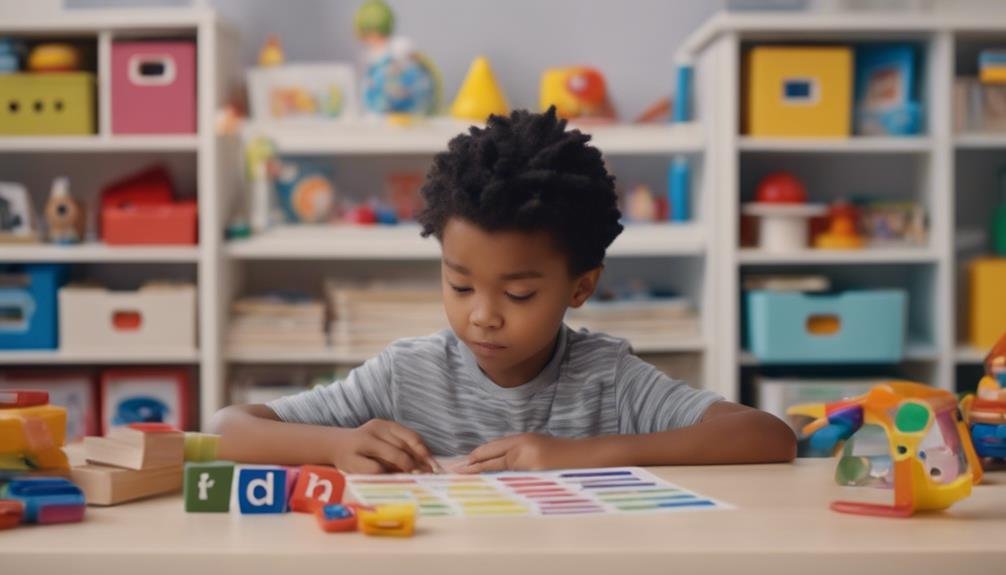"Cherishing Little Steps - A Haven for Baby and Family Journeys"
Preparing Your Child for Reading Success: Phonics Basics
As a parent, you want to give your child the best start in their educational journey. Understanding the basics of phonics is key to laying a strong foundation for their future learning.
By grasping the essential phonics principles, you can open the door to a world where words come alive and communication flourishes. But where do you begin?
Let's explore some vital strategies that will set your child on the path to reading success.
Key Takeaways
- Sound recognition through phonics is essential for reading success.
- Phonemic awareness activities aid in pre-reading skill development.
- Teaching letter sounds establishes the foundation for sound association.
- Blending and segmenting practice enhances phonics proficiency and reading fluency.
The Fundamentals of Phonics

To excel in reading, understanding the fundamentals of phonics is essential. Sound recognition forms the basis of phonics, enabling you to connect spoken language to written words. When you hear sounds like 'mmm' for the letter 'M' or 'sss' for the letter 'S', you're engaging in sound recognition. This skill helps you identify letters and their corresponding sounds, paving the way for effective reading.
Decoding skills are another important aspect of phonics. Decoding involves using your knowledge of letter sounds to sound out unfamiliar words. By breaking down words into their individual sounds and blending them together, you can decipher words accurately. This skill is integral to reading fluency and comprehension.
Importance of Phonemic Awareness
Understanding the significance of phonemic awareness lays the foundation for strong reading skills. Phonemic awareness is the ability to hear, identify, and manipulate individual sounds in spoken words, which is essential for learning to read.
Here are four key points to take into account when it comes to the importance of phonemic awareness:
- Early Intervention: Introducing phonemic awareness activities early on can help children develop essential pre-reading skills, making it easier for them to grasp the connection between letters and sounds later on.
- Different Learning Styles: Phonemic awareness activities can be tailored to suit different learning styles, whether your child is a visual, auditory, or kinesthetic learner. This flexibility allows for a more personalized and effective learning experience.
- Building Block for Reading: Phonemic awareness acts as a building block for reading success. By honing this skill, children improve their ability to decode words and enhance their overall reading fluency.
- Foundation for Spelling: Developing phonemic awareness also aids in spelling proficiency, as it helps children understand the relationship between sounds and letters in words.
Teaching Letter Sounds

As you move on to teaching letter sounds, it's important to focus on the fundamental connection between individual letters and their corresponding sounds. Letter recognition forms the basis of sound association, laying a strong foundation for your child's reading journey.
Engaging your child in multi-sensory learning experiences can enhance their understanding of letter sounds. Interactive games that involve identifying letters and their sounds in a fun way can make the learning process enjoyable and effective.
To help your child grasp letter sounds, consider incorporating activities that appeal to different senses. For instance, tracing the shape of a letter while saying its sound out loud can reinforce the association between the visual symbol and its auditory representation. Additionally, using flashcards with letters and corresponding objects or words can aid in linking the letter sound to its meaning.
Blending and Segmenting Practice
Consider practicing blending and segmenting skills to further enhance your child's phonics abilities. This will help them become more proficient in decoding words and improve their overall reading fluency. Here are some tips to help you effectively work on blending and segmenting with your child:
- Blending Techniques: Encourage your child to blend individual sounds together to form words. Start with simple consonant-vowel-consonant (CVC) words like 'cat' and gradually move to more complex words as they progress.
- Segmenting Strategies: Practice breaking words into individual sounds. You can say a word, and ask your child to identify each sound they hear. For example, for the word 'sun,' they'd segment it into /s/ /u/ /n/.
- Sound Manipulation: Engage your child in activities where they can manipulate sounds within words. Have them substitute the beginning, middle, or ending sounds of a word to create new words.
- Word Building: Use letter tiles or cards to help your child physically build words. This hands-on approach can enhance their understanding of how letters come together to form words.
Understanding Phonics Rules

To grasp the fundamentals of phonics effectively, start by familiarizing yourself with the basic rules governing the relationships between letters and sounds. Understanding phonics rules is important for your child's reading success. One common misconception is that every word follows these rules perfectly, but there are phonics exceptions that can trip up young readers. These exceptions are important to acknowledge as they can help explain why certain words don't sound out the way they're spelled.
Phonics rules are like a roadmap that guides your child through the vast landscape of words. By learning these rules, they can decode unfamiliar words with greater ease. Some parents worry that phonics rules are too rigid and don't allow for creativity in reading, but in reality, they provide a solid foundation that empowers children to become confident readers.
Sight Words and Phonics
Exploring sight words alongside phonics can enhance your child's reading proficiency and vocabulary development. By combining these two essential elements, your child can build a strong foundation for reading success.
Here's how you can effectively incorporate sight words and phonics into your child's learning routine:
- Sight Words Practice: Engage your child in regular sight words practice sessions using flashcards or interactive games. This will help them recognize common words quickly and improve their reading fluency.
- Phonics Games: Make learning phonics fun by playing interactive phonics games that reinforce letter sounds and blending. This hands-on approach can make phonics learning enjoyable and engaging for your child.
- Phonics Worksheets: Utilize phonics worksheets to provide structured practice for your child. These worksheets can help reinforce phonics rules and improve your child's decoding skills.
- Sight Word Flashcards: Create or purchase sight word flashcards to help your child memorize high-frequency words. Regular practice with flashcards can boost your child's sight word recognition and reading comprehension skills.
Engaging Phonics Activities

As you introduce your child to engaging phonics activities, focus on incorporating interactive games and hands-on exercises to make learning letter sounds and blending enjoyable and effective. Hands-on phonics games provide a fun way for your child to practice identifying and manipulating sounds. Activities like matching letter cards to objects starting with that sound or using magnetic letters to create words can enhance phonics skills.
Interactive phonics exercises, such as online games or educational apps, can also be valuable tools to reinforce letter-sound associations and blending techniques in an engaging way.
Phonics Resources for Parents
For parents seeking valuable resources to support their child's phonics learning journey, online platforms such as educational websites and interactive apps can be incredibly beneficial. Here are some suggestions to enhance your child's phonics skills at home:
- Interactive Apps: Explore interactive apps designed to make learning phonics engaging and fun for your child. Look for apps that offer interactive games, quizzes, and activities to reinforce phonics concepts in an entertaining way.
- Hands-On Games: Incorporate hands-on phonics games into your child's daily routine. Activities like phonics puzzles, word building with letter tiles, or phonics board games can make learning interactive and enjoyable.
- Online Phonics Resources: Utilize online phonics resources such as printable worksheets, flashcards, and educational videos to supplement your child's learning. These resources can provide additional practice and reinforcement of phonics skills.
- Virtual Tutoring Services: Consider enrolling your child in virtual tutoring services that specialize in phonics instruction. Professional tutors can provide personalized guidance and support to help your child master phonics concepts effectively.
Tracking Progress and Celebrating Success

To effectively track your child's progress in phonics and celebrate their successes, maintaining a consistent record of their learning milestones and achievements is essential. Setting specific goals can help guide your child's phonics journey. Start with simple objectives, like mastering specific letter sounds or recognizing certain sight words. As your child achieves these goals, be sure to celebrate their accomplishments. Rewards, whether they're small treats, extra playtime, or stickers, can motivate your child to keep pushing forward.
Motivating your child is key to their success in phonics. Offer words of encouragement and praise when they make progress. Positive reinforcement can boost their confidence and drive to learn. Remember, every child progresses at their own pace, so be patient and supportive throughout the process. Celebrate even the smallest victories to keep them engaged and excited about learning.
Frequently Asked Questions
How Can Parents Help Their Child With Reading Comprehension Skills Alongside Phonics Instruction?
To help your child with reading comprehension skills alongside phonics instruction, engage in discussions about the books they read, ask questions to check understanding, and encourage them to make connections between new words and familiar sounds.
Are There Any Specific Strategies for Helping a Child Who Struggles With Blending and Segmenting Sounds?
When blending sounds, practice with word families like -at, -an, -ig. For segmenting, use your fingers to tap out each sound. Encourage sound manipulation through games and songs. Reading fluency improves with consistent practice and positive reinforcement.
What Are Some Tips for Incorporating Phonics Practice Into Everyday Activities Outside of Formal Reading Lessons?
To incorporate phonics practice into everyday activities, try outdoor phonics games like scavenger hunts with letter clues. In the kitchen, have your child identify initial sounds of ingredients. These interactive methods make learning fun.
How Can Parents Determine if Their Child Is Ready to Move on to More Advanced Phonics Rules and Concepts?
You can assess readiness by observing fluency, decoding ability, and comprehension. Progress monitoring guarantees mastery before advancing. For example, if your child easily reads multisyllabic words, they may be ready for more complex phonics rules.
Are There Any Signs That a Child May Need Additional Support or Intervention With Phonics Instruction?
If your child struggles with reading, look for warning signs like difficulty sounding out words or blending sounds. Early intervention is essential. Provide remedial strategies like practicing sound blending to support their phonics development effectively.
Conclusion
So there you have it, parents! You now hold the power to turn your child into a reading genius with the magic of phonics.
Watch as they conquer words, sentences, and maybe even the world one phoneme at a time.
Remember, phonics is the key to unseal a treasure trove of knowledge and success for your little one.
So go forth, armed with phonics knowledge, and pave the way for your child's literary triumph!


